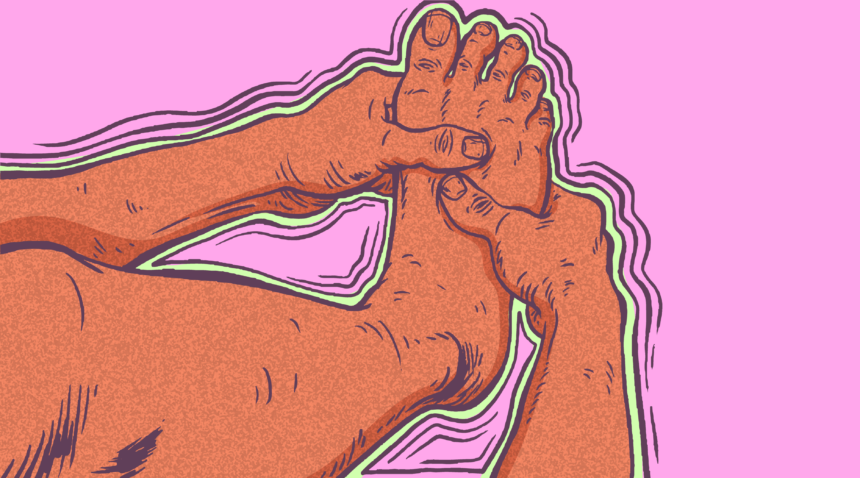If you have diabetes, you might know that foot problems, such as sores that won’t heal, are common in people with the disease. Fortunately, you can lower your chances of having diabetes-related foot problems by managing your blood sugar and taking care of your feet every day.
We talked to UNC Health podiatrist Howard E. Kashefsky, DPM, to learn more.
The Diabetes-Foot Connection
About 50 percent of people with diabetes have some kind of diabetic neuropathy (nerve damage) after 10 years.
“High blood sugars can cause irreversible nerve damage,” Dr. Kashefsky says.
The reason this occurs is still not understood, Dr. Kashefsky says.
Although the nerve damage can be in any part of the body, it most often affects the nerves in the feet and legs. This nerve damage can cause the muscles in the foot to weaken, toes to change shape or a loss of feeling in the feet. As a result, ulcers (sores) can form because a foot injury, blister, cut or pressure from shoes may go unnoticed.
The sore can become infected. The infection may not heal properly because people with diabetes are at higher risk of vascular disease, which hampers the flow of blood in their bodies and delays healing. Consistently high blood sugar may also impede healing.
“Sadly, many ulcers won’t heal if your circulation is damaged or when the blood glucose levels are too high,” Dr. Kashefsky says. “An underlying blister can become an infection or an open wound because they cannot feel their feet. And those wounds can lead down to the bone and could lead to removal of some (or all) of the foot.”
If you smoke, your risk of a future amputation is even higher, Dr. Kashefsky says. That’s because nicotine can harm the blood vessels in your legs.
Signs of Nerve Damage to the Foot
Signs of diabetic neuropathy in the foot include numbness, tingling or pain, but sometimes there aren’t any symptoms.
For this reason, it is very important to check your feet daily for cuts, redness, swelling, sores, blisters, calluses or any other change to the skin or nails if you have diabetes.
“Get in a routine of checking your feet when you put your socks on, when you take your socks off, every morning and every evening,” Dr. Kashefsky says. “And a trick is also to wear white socks so that if you do have bleeding, you might see blood on the socks. Plus, you can wash those kinds of socks with a diluted bleach, which also helps with foot hygiene.”
The Centers for Disease Control and Prevention offers these additional tips for keeping your feet healthy:
- Wash your feet daily in warm—not hot—water, but do not soak your feet. Dry your feet completely and apply lotion to the tops and bottoms. Don’t put lotion between your toes; it can cause an infection.
- Always wear shoes and socks or slippers to avoid injury. Do not go barefoot.
- Wear shoes that fit well.
- Cut your toenails straight across and carefully smooth any sharp edges with a nail file.
- Do not remove corns or calluses yourself, and don’t use over-the-counter products to remove them.
- Elevate feet when sitting, and wiggle your toes regularly throughout the day.
Also be sure to take off your shoes and socks and have your primary care physician or endocrinologist examine your feet at checkups.
“It’s helpful to have an extra set of eyes,” Dr. Kashefsky says.
When to Call the Doctor
If you have diabetes and experience any of these symptoms, call your doctor:
- Pain or cramping in your legs during physical activity
- Tingling, burning or pain in your feet
- Blisters, sores, ulcers, infected corns or ingrown toenails
- Change in the color of your feet
- Loss of sense of touch or ability to feel heat or cold
- Change in the shape of your feet
- Fungal infections, such as athlete’s foot between your toes
- Hair loss on your feet or legs
- Thick, yellow toenails
Keep Blood Sugar Under Control to Prevent Foot Problems
Keeping your diabetes in check and your blood sugar under control dramatically reduces your chances of developing foot problems.
“Manage your diabetes aggressively. Don’t ignore your blood sugars, and don’t wait until you have symptoms,” Dr. Kashefsky says. ”High blood sugars are often not symptomatic, and what happens is that when the problem gets to the level where they have to see me for an infection, irreversible problems have already happened.”
You will need to see a foot doctor if a sore does not heal.
“If the patient’s well-controlled with their diabetes and they have good blood flow, we can do corrective surgery and prevent recurrence,” Dr. Kashefsky says.
In other words, if surgery is needed, it is to fix underlying problems to prevent recurrence rather than for amputation.
Do you have foot problems and diabetes? Talk to your doctor or find one near you.

